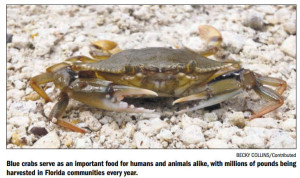 What’s the first thing you think of when you think of blue crabs? Many of us may think of our favorite foods, everything from soup to crab cakes. Even the scientific name of the blue crab, Callinectes sapidus, translates to “beautiful savory swimmer.” These crabs serve as an important food for humans and animals alike, with millions of pounds of blue crabs being harvested in Florida communities every year. Working together, we can do many different things to help blue crabs thrive in our waters for years to come.
What’s the first thing you think of when you think of blue crabs? Many of us may think of our favorite foods, everything from soup to crab cakes. Even the scientific name of the blue crab, Callinectes sapidus, translates to “beautiful savory swimmer.” These crabs serve as an important food for humans and animals alike, with millions of pounds of blue crabs being harvested in Florida communities every year. Working together, we can do many different things to help blue crabs thrive in our waters for years to come.
Blue crabs don’t have a backbone, but they are not afraid to use their claws to pinch anything that tries to grab them or to nab their next meal. They use the rest of their legs to move around by walking and swimming. Their front three pairs of legs help them to walk along the bottom, and their two back legs, called swimerettes, help them swim. These crabs are not picky about their next meal and will eat just about anything they can find, including other blue crabs.
Some people know which gender of crabs they’re ordering by the names given to them by harvesters. Oftentimes, male crabs are known as “Jimmys,” mature female crabs are called “Sooks” and immature females are called “Sallys.” How can you tell the different genders if you see a crab in the water? To tell the difference you can use two clues on the crab’s body, the claws and the apron. The claws of female blue crabs are red-tipped, while the males have mostly blue claws. Located on the bottom of the crab is the apron, or abdomen, which is shaped differently on males and females. The male’s apron is long and pointed, the mature female’s is more circular-shaped, and the immature female’s is pyramid-shaped. If you find a crab with something that looks like an orange sponge on the apron, it is a female crab with eggs. That’s why female crabs with eggs are called sponge crabs. While there is no regulation against harvesting female crabs that are not bearing eggs, the female crabs can only mate once in their lives. A conservation effort many crabbers practice is releasing females back into the ocean so they can ensure the females have a chance to reproduce. This is one thing that we can do to help blue crabs in our waters.
The Florida Keys are a beautiful paradise in which to live work and play. If you spend any time here, you will soon learn that we love our community, including our reefs, mangroves and ocean. Many animals, including blue crabs, need a clean and usable home to live in, just as we do. Working together, we can help keep these habitats clean and in good condition. This will help everyone, including blue crabs, not only survive, but also thrive. If you want to learn more about blue crabs, or to see some of their habitats, visit “The Real Florida” at any of the state parks here in the Florida Keys.
Visit FloridaStateParks.org and plan your next outdoor adventure. Lindsey Crews is a park ranger at John Pennekamp Coral Reef State Park.
